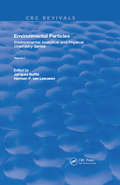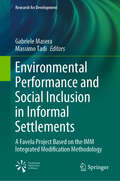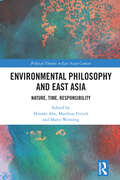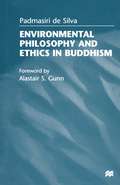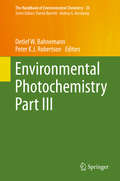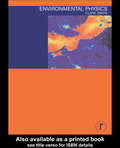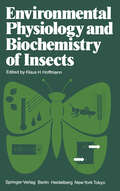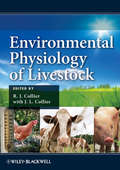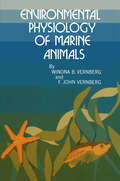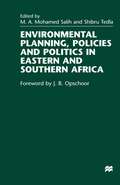- Table View
- List View
Environmental Organic Chemistry
by Philip M. Gschwend Dieter M. Imboden René P. SchwarzenbachExamines in a pedagogical way all pertinent molecular and macroscopic processes that govern the distribution and fate of organic chemicals in the environment and provides simple modeling tools to quantitatively describe these processes and their interplay in a given environmental system Treats fundamental aspects of chemistry, physics, and mathematical modeling as applied to environmentally relevant problems, and gives a state of the art account of the field Teaches the reader how to relate the structure of a given chemical to its physical chemical properties and intrinsic reactivities Provides a holistic and teachable treatment of phase partitioning and transformation processes, as well as a more focused and tailor-made presentation of physical, mathematical, and modeling aspects that apply to environmental situations of concern Includes a large number of questions and problems allowing teachers to explore the depth of understanding of their students or allowing individuals who use the book for self-study to check their progress Provides a companion website, which includes solutions for all problems as well as a large compilation of physical constants and compound properties
Environmental Participation: Practices engaging the public with science and governance
by Catharina LandströmThis book introduces environmental participation as a distinct field comprising diverse practices. It presents examples of public participation specifically in environmental science, decision making and expertise. The first chapter introduces the science studies perspective and the key concepts that underpin the argument for approaching such a range of practices as a coherent field. The following three chapters explore a wide range of practical examples of how the public can participate in all three domains. Drawing on her experience with a variety of transdisciplinary projects Landström discusses topics including the coproduction of knowledge about flooding, community involvement with radioactive waste disposal and collaborative water quality modelling. She then goes on to cover citizen science and social movement expertise as environmental participation practices. The concluding chapter reflects on the challenges as well as future opportunities of environmental participation. This book is aimed at readers from a variety of academic and non-academic backgrounds and will be a great interest to social and natural scientists, students and practitioners.
Environmental Particles: Volume 1 (Routledge Revivals)
by Jacques Buffle Herman P. van LeeuwenFirst published in 1992, Environmental Particles describes properties, roles, and methods for the characterization of environmental particles in air, water, sediment, and soil. This book emphasizes modern methods for sampling, instrumental characterization methods, and physical/chemical principles for describing the properties and roles of particles in the environment (particularly their influence on the transport of toxic compounds). It will be an excellent reference source for environmental chemists and physicists, limnologists, oceanographers, air and soil scientists, analytical chemists, environmental engineers, scientists involved in environmental protection, and students.
Environmental Particles: Volume 1 (Routledge Revivals)
by Jacques Buffle Herman P. van LeeuwenFirst published in 1992, Environmental Particles describes properties, roles, and methods for the characterization of environmental particles in air, water, sediment, and soil. This book emphasizes modern methods for sampling, instrumental characterization methods, and physical/chemical principles for describing the properties and roles of particles in the environment (particularly their influence on the transport of toxic compounds). It will be an excellent reference source for environmental chemists and physicists, limnologists, oceanographers, air and soil scientists, analytical chemists, environmental engineers, scientists involved in environmental protection, and students.
Environmental Performance and Social Inclusion in Informal Settlements: A Favela Project Based on the IMM Integrated Modification Methodology (Research for Development)
by Gabriele Masera Massimo TadiThis book discusses the potential of a systemic and multidisciplinary design approach to improve urban quality, health, livability, and inclusiveness for people living in informal settlements. In most instances, attempts to address informal settlements lack an adequate assessment of their impact on the wider built environment and implementation of the UN’s Sustainable Development Goals. The Integrated Modification Methodology (IMM), introduced here, offers a systematic, multidisciplinary design tool encompassing several of the aspects that define the environmental performance of urban systems. The book also demonstrates the application of the methodology to an informal settlement, proving its potential to guide systemicurban transformations, also in urban areas lacking formal planning. The case study investigated is in the Rocinha favela in Rio de Janeiro, which ischaracterized by poor water quality, lack of drainage and sanitation systems, and very few green spaces. Based on a rigorous methodology, the process described here can also be applied in similar contexts around the world.
Environmental Perspectives: A Brief Overview of Selected Topics (SpringerBriefs in Environmental Science)
by Neil ShifrinThis short, readable book is intended as a big-picture introduction/overview for environmental students and lay-people involved with environmental issues. Every freshman in college intending to study environmental science should read it. It begins with a historical perspective on waste and environmental control. Basic instruction on some important fundamentals faced by environmental professionals every day, such as sampling, analysis, data visualization, risk assessment and forensic chemistry are provided in the following chapter. Important regulatory fundamentals, such as the National Contingency Plan, which is the U.S. regulatory framework for addressing hazardous waste is also defined. The book concludes with pertinent and provocative considerations on the future of environmental management, such as alternative approaches (technical impracticability), the “not-in-my-backyard syndrome,” and the safety of chemicals in consumer products. The book contains many useful facts about waste production rates, energy use and recycling rates—all referenced to allow substantiation and provide a springboard for further research.
Environmental Pest Management: Challenges for Agronomists, Ecologists, Economists and Policymakers
by Moshe Coll Eric WajnbergA wide-ranging, interdisciplinary exploration of key topics that interrelate pest management, public health and the environment This book takes a unique, multidimensional approach to addressing the complex issues surrounding pest management activities and their impacts on the environment and human health, and environmental effects on plant protection practices. It features contributions by a distinguished group of authors from ten countries, representing an array of disciplines. They include plant protection scientists and officers, economists, agronomists, ecologists, environmental and public health scientists and government policymakers. Over the course of eighteen chapters, those experts share their insights into and analyses of an array of issues of vital concern to everyone with a professional interest in this important subject. The adverse effects of pest control have become a subject of great concern worldwide, and researchers and enlightened policymakers have at last begun to appreciate the impact of environmental factors on our ability to manage pest populations. Moreover, while issues such as pesticide toxicity have dominated the global conversation about pest management, economic and societal considerations have been largely neglected. Environmental Pest Management: Challenges for Agronomists, Ecologists, Economists and Policymakers is the first work to provide in-depth coverage of all of these pressing issues between the covers of one book. Offers a unique multi-dimensional perspective on the complex issues surrounding pest management activities and their effect on the environment and human health Addresses growing concerns about specific pest management strategies, including the use of transgenic crops and biological controls Analyses the influence of global processes, such as climate change, biological invasions and shifts in consumer demand, and ecosystem services and disservices on pest suppression efforts Explores public health concerns regarding biodiversity, pesticide use and food safety Identifies key economic drivers of pest suppression research, strategies and technologies Proposes new regulatory approaches to create sustainable and viable crop protection systems in the framework of agro-environmental schemes Offering a timely and comprehensively-unique treatment of pest management and its environmental impacts in a single, inter-disciplinary volume, this book is a valuable resource for scientists in an array of disciplines, as well as government officials and policymakers. Also, teachers of undergraduate and graduate level courses in a variety of fields are sure to find it a highly useful teaching resource.
Environmental Pest Management: Challenges for Agronomists, Ecologists, Economists and Policymakers
by Eric Wajnberg Moshe CollA wide-ranging, interdisciplinary exploration of key topics that interrelate pest management, public health and the environment This book takes a unique, multidimensional approach to addressing the complex issues surrounding pest management activities and their impacts on the environment and human health, and environmental effects on plant protection practices. It features contributions by a distinguished group of authors from ten countries, representing an array of disciplines. They include plant protection scientists and officers, economists, agronomists, ecologists, environmental and public health scientists and government policymakers. Over the course of eighteen chapters, those experts share their insights into and analyses of an array of issues of vital concern to everyone with a professional interest in this important subject. The adverse effects of pest control have become a subject of great concern worldwide, and researchers and enlightened policymakers have at last begun to appreciate the impact of environmental factors on our ability to manage pest populations. Moreover, while issues such as pesticide toxicity have dominated the global conversation about pest management, economic and societal considerations have been largely neglected. Environmental Pest Management: Challenges for Agronomists, Ecologists, Economists and Policymakers is the first work to provide in-depth coverage of all of these pressing issues between the covers of one book. Offers a unique multi-dimensional perspective on the complex issues surrounding pest management activities and their effect on the environment and human health Addresses growing concerns about specific pest management strategies, including the use of transgenic crops and biological controls Analyses the influence of global processes, such as climate change, biological invasions and shifts in consumer demand, and ecosystem services and disservices on pest suppression efforts Explores public health concerns regarding biodiversity, pesticide use and food safety Identifies key economic drivers of pest suppression research, strategies and technologies Proposes new regulatory approaches to create sustainable and viable crop protection systems in the framework of agro-environmental schemes Offering a timely and comprehensively-unique treatment of pest management and its environmental impacts in a single, inter-disciplinary volume, this book is a valuable resource for scientists in an array of disciplines, as well as government officials and policymakers. Also, teachers of undergraduate and graduate level courses in a variety of fields are sure to find it a highly useful teaching resource.
Environmental Philosophy and East Asia: Nature, Time, Responsibility (Political Theories in East Asian Context)
by Hiroshi Abe Matthias Fritsch Mario WenningThis book explores the contributions of East Asian traditions, particularly Buddhism and Daoism, to environmental philosophy in dialogue with European philosophy. It critically examines the conceptions of human responsibility toward nature and across time presented within these traditions.The volume rethinks human relationships to the natural world by focusing on three main themes: Daoist and Eurodaoist perspectives on nature, human responsibility toward nature, and Buddhist perspectives on life and nature. By way of discussing East Asian traditions and European thinkers, this collection reveals that the impact of humanity on the environment is shaped not only by distinctive modes of economic production, but also by cultural beliefs and practices. Representing a unique constellation of environmental and intercultural philosophy, the contributions present systematic approaches to the global need for cultivating environmental responsibility across cultures and generations to address the political, ethical, and aesthetic challenges arising from humanity’s transformative impact on the natural world.Presenting a critical re-evaluation of human relationships to the natural world in dialogue with East Asian traditions, this will be a valuable resource for students and scholars of Philosophy, Environmental Studies and Asian Studies.
Environmental Philosophy and East Asia: Nature, Time, Responsibility (Political Theories in East Asian Context)
by Hiroshi Abe Matthias Fritsch Mario WenningThis book explores the contributions of East Asian traditions, particularly Buddhism and Daoism, to environmental philosophy in dialogue with European philosophy. It critically examines the conceptions of human responsibility toward nature and across time presented within these traditions.The volume rethinks human relationships to the natural world by focusing on three main themes: Daoist and Eurodaoist perspectives on nature, human responsibility toward nature, and Buddhist perspectives on life and nature. By way of discussing East Asian traditions and European thinkers, this collection reveals that the impact of humanity on the environment is shaped not only by distinctive modes of economic production, but also by cultural beliefs and practices. Representing a unique constellation of environmental and intercultural philosophy, the contributions present systematic approaches to the global need for cultivating environmental responsibility across cultures and generations to address the political, ethical, and aesthetic challenges arising from humanity’s transformative impact on the natural world.Presenting a critical re-evaluation of human relationships to the natural world in dialogue with East Asian traditions, this will be a valuable resource for students and scholars of Philosophy, Environmental Studies and Asian Studies.
Environmental Philosophy and Ethics in Buddhism
by Padmasiri De SilvaThis work introduces the reader to the central issues and theories in western environmental ethics, and against this background develops a Buddhist environmental philosophy and code of ethics. It contains a lucid exposition of Buddhist environmentalism, its ethics, economics and Buddhist perspectives for environmental education. The work is focused on a diagnosis of the contemporary environmental crisis and a Buddhist contribution to positive solutions. Replete with stories and illustrations from original Buddhist sources, it is both informative and engaging.
Environmental Photochemistry (The Handbook of Environmental Chemistry #2 / 2L)
by Pierre BouleEnvironmental Chemistry is a relatively young science. Interest in this subject, however, is growing very rapidly and, although no agreement has been reached as yet about the exact content and limits of this interdisciplinary discipline, there appears to be increasing interest in seeing environmental topics which are based on chemistry embodied in this subject. One of the first objectives of Environ mental Chemistry must be the study of the environment and of natural chemical processes which occur in the environment. A major purpose of this series on Environmental Chemistry, therefore, is to present a reasonably uniform view of various aspects of the chemistry of the environment and chemical reactions occurring in the environment. The industrial activities of man have given a new dimension to Environ mental Chemistry. We have now synthesized and described over five million chemical compounds and chemical industry produces about hundred and fifty million tons of synthetic chemicals annually. We ship billions of tons of oil per year and through mining operations and other geophysical modifications, large quantities of inorganic and organic materials are released from their natural deposits. Cities and metropolitan areas of up to 15 million inhabitants produce large quantities of waste in relatively small and confined areas. Much of the chemical products and waste products of modern society are released into the environment either during production, storage, transport, use or ultimate disposal. These released materials participate in natural cycles and reactions and frequently lead to interference and disturbance of natural systems.
Environmental Photochemistry Part III (The Handbook of Environmental Chemistry #35)
by Detlef W. Bahnemann Peter K. J. RobertsonThis volume builds on the previous two editions, Environmental Photochemistry Part I and Part II, which reflect the diverse range of activities in this highly dynamic research field. The chapters cover fundamental topics, from photocatalyst materials, surface-modified materials, reaction kinetics and reactor modelling, to translational research activities on chemical synthesis, energy conversion and water treatment. The applications of the new generation of LED irradiation sources and spectroscopic methods for elucidating reaction pathways are also covered in detail. This new volume maintains the ethos of the previous editions by further contributing to readers’ understanding of photochemical and photocatalytic processes for environmental applications.
Environmental Physics: Sustainable Energy and Climate Change
by Egbert Boeker Rienk van GrondelleThis thoroughly revised and updated third edition focuses on the utilization of sustainable energy and mitigating climate change, serving as an introduction to physics in the context of societal problems. A distinguishing feature of the text is the discussion of spectroscopy and spectroscopic methods as a crucial means to quantitatively analyze and monitor the condition of the environment, the factors determining climate change, and all aspects of energy conversion. This textbook will be invaluable to students in physics and related subjects, and supplementary materials are available on a companion website.
Environmental Physics: Sustainable Energy and Climate Change
by Egbert Boeker Rienk van GrondelleThis thoroughly revised and updated third edition focuses on the utilization of sustainable energy and mitigating climate change, serving as an introduction to physics in the context of societal problems. A distinguishing feature of the text is the discussion of spectroscopy and spectroscopic methods as a crucial means to quantitatively analyze and monitor the condition of the environment, the factors determining climate change, and all aspects of energy conversion. This textbook will be invaluable to students in physics and related subjects, and supplementary materials are available on a companion website.
Environmental Physics (Routledge Introductions to Environment: Environmental Science)
by Clare SmithEnvironmental Physics is a comprehensive introduction to the physical concepts underlying environmental science. The importance and relevance of physics is emphasised by its application to real environmental problems with a wide range of case studies. Applications included cover energy use and production, global climate, the physics of living things, radioactivity, environmental remote sensing, noise pollution and the physics of the Earth. The book makes the subject accessible to those with little physics background, keeping mathematical treatment straightforward. The text is lively and informative, and is supplemented by numerous illustrations, photos, tables of useful data, and a glossary of key terms.
Environmental Physics (Routledge Introductions to Environment: Environmental Science)
by Clare SmithEnvironmental Physics is a comprehensive introduction to the physical concepts underlying environmental science. The importance and relevance of physics is emphasised by its application to real environmental problems with a wide range of case studies. Applications included cover energy use and production, global climate, the physics of living things, radioactivity, environmental remote sensing, noise pollution and the physics of the Earth. The book makes the subject accessible to those with little physics background, keeping mathematical treatment straightforward. The text is lively and informative, and is supplemented by numerous illustrations, photos, tables of useful data, and a glossary of key terms.
Environmental Physics (Routledge Introductions To Environment: Environmental Science Ser.)
by Clare SmithFirst Published in 2002. Environmental Physics is a comprehensive introduction to the physical concepts underlying environmental science. The importance and relevance of physics is emphasised by its application to real environmental problems with a wide range of case studies. Applications included cover energy use and production, global climate, the physics of living things, radioactivity, environmental remote sensing, noise pollution and the physics of the Earth. The book makes the subject accessible to those with little physics background, keeping mathematical treatment straightforward. The text is lively and informative, and is supplemented by numerous illustrations, photos, tables of useful data, and a glossary of key terms.
Environmental Physics
by Clare SmithFirst Published in 2002. Environmental Physics is a comprehensive introduction to the physical concepts underlying environmental science. The importance and relevance of physics is emphasised by its application to real environmental problems with a wide range of case studies. Applications included cover energy use and production, global climate, the physics of living things, radioactivity, environmental remote sensing, noise pollution and the physics of the Earth. The book makes the subject accessible to those with little physics background, keeping mathematical treatment straightforward. The text is lively and informative, and is supplemented by numerous illustrations, photos, tables of useful data, and a glossary of key terms.
Environmental Physiology and Biochemistry of Insects
by K. H HoffmannOf all the zoological classes the insects are the most numerous in species and the most varied in structure. Estimates of the number 18 of species vary from 1 to 10 million, and 10 individuals are es timated to be alive at any given moment. In their evolution, in sects are relatively ancient and, therefore, they have proved to be a phenomenally successful biological design which has survived unchanged in its basic winged form during the last 300 m. y. In sects were the first small animals to colonize the land with full suc cess. Their small size opened many more ecological niches to them and permitted a greater diversification than the vertebrates. What is it about this design that has made insects so successful in habitats stretching from arid deserts to the Arctic and Antarctic and from freshwater brooks to hot springs and salines? Is it due to the adapta bility of their behavior, physiology, and biochemistry to changing environmental conditions? Three features of insects are of particular importance in determin ing their physiological relationship with the environment: their small size, as mentioned above, the impermeability and rigidity of their exoskeleton, and their poikilothermy. Of course, as with any other animals, the insects' success in its environment depends on its ability to maintain its internal state within certain tolerable limits of temperature, osmotic pressure, pH or oxygen concentra tion (homoeostasis).
Environmental Physiology of Animals
by Pat Willmer Graham Stone Ian JohnstonThe new and updated edition of this accessible text provides a comprehensive overview of the comparative physiology of animals within an environmental context. Includes two brand new chapters on Nerves and Muscles and the Endocrine System. Discusses both comparative systems physiology and environmental physiology. Analyses and integrates problems and adaptations for each kind of environment: marine, seashore and estuary, freshwater, terrestrial and parasitic. Examines mechanisms and responses beyond physiology. Applies an evolutionary perspective to the analysis of environmental adaptation. Provides modern molecular biology insights into the mechanistic basis of adaptation, and takes the level of analysis beyond the cell to the membrane, enzyme and gene. Incorporates more varied material from a wide range of animal types, with less of a focus purely on terrestrial reptiles, birds and mammals and rather more about the spectacularly successful strategies of invertebrates. A companion site for this book with artwork for downloading is available at: www.blackwellpublishing.com/willmer/
Environmental Physiology of Livestock
by R. J. CollierEnvironmental stress is one of the most significant factors affecting livestock performance and health, and it is only expected to increase with effects of global warming. Environmental Physiology of Livestock brings together the latest research on environmental physiology, summarizing progress in the field and providing directions for future research. Recent developments in estimating heat stress loads are discussed, as well as key studies in metabolism, reproduction, and genetic expressions. Environmental Physiology of Livestock begins with a survey of current heat indexing tools, highlighting recent discoveries in animal physiology, changes in productivity levels, and new technologies available to better estimate stress response. Using this synopsis as a point of orientation, later chapters hone in on major effects of heat stress, including changing metabolic pathways and nutrient requirements, endocrine regulation of acclimation to environmental stress, and reduced reproductive performance. The text concludes with a thorough discussion of environmental effects on gene expressions, providing important insight for future breeding practices. Environmental Physiology of Livestock is a globally contributed volume and a key resource for animal science researchers, geneticists, and breeders.
Environmental Physiology of Livestock
by R. J. Collier J. L. CollierEnvironmental stress is one of the most significant factors affecting livestock performance and health, and it is only expected to increase with effects of global warming. Environmental Physiology of Livestock brings together the latest research on environmental physiology, summarizing progress in the field and providing directions for future research. Recent developments in estimating heat stress loads are discussed, as well as key studies in metabolism, reproduction, and genetic expressions. Environmental Physiology of Livestock begins with a survey of current heat indexing tools, highlighting recent discoveries in animal physiology, changes in productivity levels, and new technologies available to better estimate stress response. Using this synopsis as a point of orientation, later chapters hone in on major effects of heat stress, including changing metabolic pathways and nutrient requirements, endocrine regulation of acclimation to environmental stress, and reduced reproductive performance. The text concludes with a thorough discussion of environmental effects on gene expressions, providing important insight for future breeding practices. Environmental Physiology of Livestock is a globally contributed volume and a key resource for animal science researchers, geneticists, and breeders.
Environmental Physiology of Marine Animals
by W. B. Vernberg F. J. VernbergWithin recent years man has become increasingly aware of the disastrous environmental changes that he has introduced, and therefore society is now more concerned about understanding the adaptations organisms have evolved in order to survive and flourish in their environment. Because much of the information pertaining to this subject is scattered in various journals or special symposia proceedings, our purpose in writing this book is to bring together in a college-and graduate-student text the principal concepts of the environmental physiology of the animals that inhabit one of the major realms of the earth, the sea. Our book is not meant to be a definitive treatise on the physiological adap tation of the animals that inhabit the marine environment. Instead, we have tried to highlight some of the physiological mechanisms through which these animals have been able to meet the challenges of their environment. We have not written this book for anyone particular scientific discipline; rather, we hope that it will have an interdisciplinary appeal. It is meant to be both a reference text and a text for teaching senior undergraduate and graduate courses in marine biology, physiological ecology of marine animals, and envi ronmental physiology of marine animals.
Environmental Planning, Policies and Politics in Eastern and Southern Africa
by M. A. Mohamed Salih Shibru TedlaCaught between underdevelopment, poverty and environmental degradation, and the need for exploiting their natural resources for development, Africa has, during the last two decades, been engaged in a serious effort to integrate environment and development. The nine case studies (Botswana, Ethiopia, Kenya, Lesotho, Malawi, Tanzania, Sudan, Uganda and Zambia) presented in this book explore the complexity involved in environmental planning and policy in one of the World's poorest regions. The authors articulate an informed debate, with new conclusions and alternative policy recommendations.


